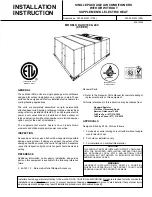
8
8. Turn the thermostat system switch to “OFF” and disconnect
all power when servicing the unit.
Heat Pump Start-Up Procedure
9. Check the cooling mode for the heat pump in the same
manner as above. The reversing valve is energized when
the thermostat is placed in the cooling position. A clicking
sound should be noticeable from the reversing valve. By lowering the temperature setting to call for cooling, the
contractor is energized. The compressor,
blower and fan should then be running. After
the cooling mode is checked out, turn the
thermostat system switch to “OFF
”.
10. Turn the thermostat system switch to “HEAT”
and fan switch to “AUTO
”.
11. Slowly raise the heating temperature setting.
When the heating first stage makes contact,
stop raising the temperature setting.. The
compressor, blower and fan should now be
running with the reversing valve in the de-
energized (heating) position. After giving the
unit time to settle out, make sure the unit is
supplying heated air.
12. If the out door ambient is above 80°F, the
unit may trip on its high pressure cut out when
on heating. The compressor should stop. The
heating cycle must be thoroughly checked,
so postpone the test to another day when
conditions are more suitable but-DO NOT FAIL
TO TEST.
If the out door ambient is low and the unit
operates properly on the heating cycle, you
may check the pressure cutout operation by
blocking off the indoor return air until the
unit trips.
13. If unit operates properly in the heating cycle,
raise the temperature setting until the heating
second stage makes contact. Supplemental
resistance heat, if installed should now come
on. Make sure it operates properly.
NOTE: If outdoor thermostats are installed
the outdoor ambient must be below the set
point of these thermostats for the heaters
to operate. It may be necessary to jumper
these thermostats to check heater
operation if outdoor ambient is mild.
14. For thermostats with emergency heat switch,
return to step 11. The emergency heat switch
is located at the bottom of the thermostat.
Move the switch to emergency heat. The heat
pump will stop, the blower will continue to
run, all heaters will come on and the
thermostat emergency heat light will come
on.
15. If checking the unit in the wintertime, when the outdoor coil is cold enough to actuate the defrost control, observe at
least one defrost cycle to make sure the unit defrosts completely.
Final System Checks
16. Check to see if all supply and return air grilles are adjusted and the air distribution system is balanced for the best
compromise between heating and cooling.
17. Check for air leaks in the ductwork.
18. See Sections on
Air Flow Measurement and Adjustment
and
Checking Charge
.
WARNING
HIGH
VOLTAGE
!
D
ISCONNECT
ALL
POWER BEFORE SERVICING OR INSTALLING
THIS UNIT.
M
ULTIPLE POWER SOURCES MAY BE PRESENT. FAILU
TO DO SO MAY CAUSE PROPERTY DAMAGE, PERSONAL INJURY O
DEATH.
RE
R
E
V
A
P
O
R
A
T
O
R
COOLING
SE RV IC E VA LV E
SE RVIC E PO RT
RE VE RSING V ALVE
C
O
N
D
E
N
S
E
R
SE RV IC E PO RT
CO M PR ESS OR
SE RVIC E PO RT
AC CUM ULATO R
EX PA NSION DEV IC E
CH ECK VALVE
OR IF ICE
SE RV IC E
VA LV E
CH ECK VAL VE
OR IF ICE
INDO OR
CO IL
DIST RIBU TOR
OU TDO OR
CO IL
E
V
A
P
O
R
A
T
O
R
HEATIN G
SE RVIC E VA LV E
SE RV IC E PO RT
RE VE RSING VALVE
C
O
N
D
E
N
S
E
R
CO M PR ESS OR
SE RV IC E PO RT
AC CUM UL ATO R
CH ECK VAL VE
OR IF ICE
SE RV IC E
VA LV E
CH ECK VALVE
OR IFICE
INDO OR
CO IL
DISTRIBU TOR
OU TDO OR
CO IL
DIST RIBU TOR
HEAT PUMP REFRIGERANT CIRCUIt - FIGURE 7






































